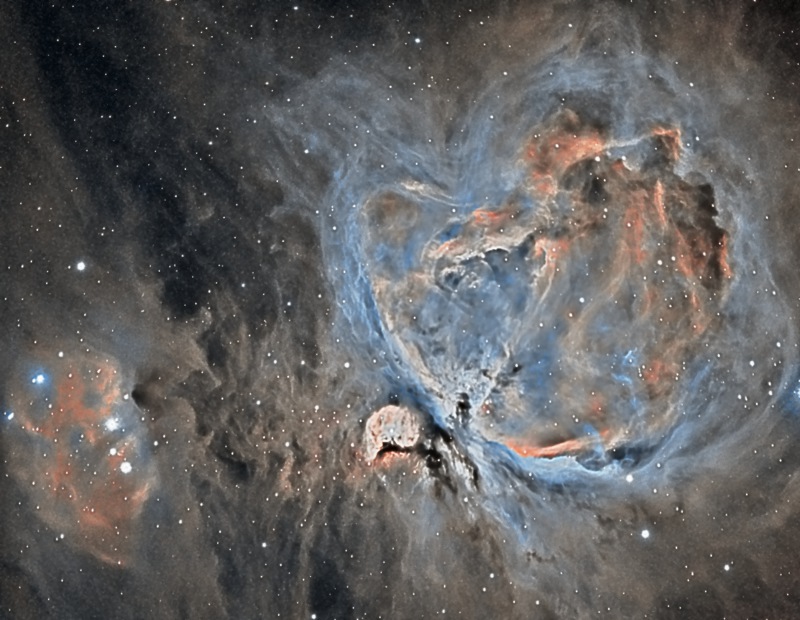This color image is composed of three independent monochrome images taken in H-alpha, SII and OIII narrowbands. The total exposure time was more than 15 hours using a rather modest ED telescope of just 80mm diameter, with a SC reducer to get a 350mm focal lenght telescope at f/4.3. Every single narrowand image was created as High Dynamic Range combining exposures from 10s to 800s to avoid saturation of the nebula core.
It is one of the brightest nebulae, and is visible to the naked eye in the night sky. M42 is located at a distance of 1,270±76 light years and is the closest region of massive star formation to Earth. The M42 nebula is estimated to be 24 light years across. Older texts frequently referred to the Orion Nebula as the Great Nebula in Orion or the Great Orion Nebula. Yet older, astrological texts refer to it as Ensis, which is also the name of the star Eta Orionis.
The Orion Nebula is considered to be one of the most scrutinized and photographed objects in the night sky, and is among the most intensely studied celestial features. The nebula has revealed much about the process of how stars and planetary systems are formed from collapsing clouds of gas and dust. Astronomers have directly observed protoplanetary disks, brown dwarfs, intense and turbulent motions of the gas, and the photo-ionizing effects of massive nearby stars in the nebula.
The annotated version shows part of the classical naming of the nebula. These names comes from well known observers as Huygens, Gentil, Picard or Messier as used by Herschell, Struve or Rosse.
Other names refer to the face of a fish, being the Sinus magnus the mouth (other names used are restrum, frons and occiput, not shown here).
The term Sinus magnus was used by John Herschel in his publication of 1837 (or perhaps 1824), Bond (1861, 1867) and has been maintained by Holden, 1860.
The earliest use of "the Fish's mouth" was made by W. H. Smyth in 1844 (in Bedford catalog) and has been a term used until now by many observers Anglophones.
(Special thanks to Dr. Patricio Dominguez for these naming details)
Esta imagen en color falso está compuesta de tres imágenes independientes monocromo correpondientes a las bandas estrechas de Hidrógeno alfa, Sulfuro doblemente ionizado (SII) y Oxígeno triplemente ionizado (OIII). El tiempo total de exposición fue de más de 15 horas usando un más bien modesto telescopio ED de 80mm de diámetro con un reductor de SC para obtener 350mm de focal con una relación de f/4.3. Cada una de las imágenes monocromas en banda estrecha fue creada como HDR (High Dynamic Range) de 64 bits combinando exposiciones desde 10s hasta 800s para no saturar el núcleo de la nebulosa.
Esta es una de las nebulosas más brillantes, y es visible a simple vista en el cielo nocturno. M42 se encuentra a una distancia de 1.270 ± 76 años luz y es la región de formación de estrellas masivas más cercana a la Tierra. La nebulosa M42 se estima que tiene 24 años luz de diámetro. Los textos más antiguos con frecuencia se refiere a la Nebulosa de Orión como la Gran Nebulosa de Orión. Textos astrológicos incluso más antiguos se refieren a ella como Ensis, que es también el nombre de la estrella Eta Orionis (cuyo halo se aprecia a la derecha en esta imagen).
La Nebulosa de Orión es considerado como uno de los objetos más analizados y fotografiados en el cielo nocturno, y contiene algunas de las características más estudiadas. La nebulosa ha revelado mucho sobre el proceso de cómo las estrellas y sistemas planetarios se forman a partir colapso de nubes de gas y polvo. Los astrónomos han observado directamente los discos protoplanetarios, enanas marrones, los movimientos intensos y turbulentos del gas, y los efectos de la foto-ionización de estrellas masivas cercanas en la nebulosa.
La versión con texto muestra parte de la denominación clásica de la nebulosa. Estos nombres provienen de observadores clásicos como Huygens, Gentil, Picard o Messier, tal y como los usaron Herschell, Struve o Rosse.
Otros nombres se refieren a la cara de un pez, siendo Sinus Magnus la boca (los demás nombres usados son restrum, frons y occipital, no mostrado aquí).
El término Sinus Magnus fue utilizado por John Herschel en su publicación de 1837 (o tal vez 1824), Bond (1861, 1867) y ha sido mantenida por Holden, 1860.
El primer uso de "the Fish's mouth" (la boca del pez) fue hecha por W.H. Smyth en 1844 (en el Bedford catalogue) y ha sido un término utilizado hasta la actualidad por muchos observadores anglófonos.
(Un agradecimiento especial al Dr. Patricio Domínguez por facilitarme estos detalles sobre nomenclatura)
|

